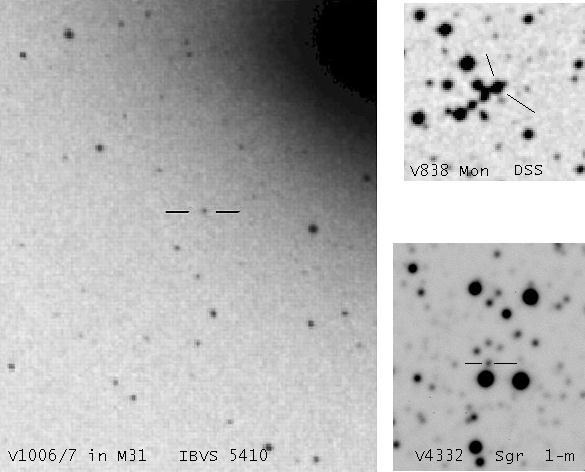| Peculiar Nova | R.A. 2000 | Decl. 2000 |
| V1006/7 M31 | 00h43m02s.42 | +41o 12' 56".9 |
| V838 Mon | 07 04 04.85 | -03 50 51.1 |
| V4332 Sgr | 18 50 36.73 | -21 23 28.9 |
V1006/7 M31 = RV = McD 88 No.1. History of investigation.
The nova reached the brightness of B = 17m.5, V = 15m.5 (B-V = 1m.89+/-0.24) in the outburst (A.S.Sharov, Astronomy Letters v.19, 335, 1993). In the previous Sharov's paper, some more outburst of this star in 1968 was reported (SvAL v.16, 855,1990), but later in the paper of 1993 it was disproved. In that way, the event in 1988 is only reliable outburst of this star that was registered in 1100 negatives of Sternberg Astronomical Institute collection in the time range between 1967 and 1992. In the spectrum of nova obtained by Rich et al.ApJ V.341, L51, 1989), BaII, CaI and FeI lines predominate on the background of red continuum, the line of Li at 6708A is seen, too.
Photometry and spectroscopy of V838 Mon
Nova V838 Mon was discovered by N.J. Brown in January 6, 2002. It is the most studied object of new class. The pre-maximum stage lasted to February 2, 2002. Maximum of brightness was reached in February 6, 2002 in the peak of the outburst that resembled an outgoing shock wave into a star surface. A second local maximum was observed in 32 days after main maximum.

Light curves of V838 Mon before 2002, in the outburst and after
the outburst in B and red RC bands.
See also an UBVR collection
of observations, including light curves and color indices according to
modern data.
Nova shows different behaviour in the filters of system RJ
by Johnson and RC by Cousins.
Spectral observations of V838 Mon in the outburst
showed that the star had normal solar like abundance of elements,
and hydrogen rich envelope. Strong line of Li 6708A was idendified.
Intensive absorbtion bands of TiO, VO, AlO and oxides of other
metalls are seen in optical spectra of V838 Mon obtained with the 6-m
telescope in 2004. This is a typical behaviour of oxygen rich cool stars.
These properties distinguish V838 Mon radically from post-AGB flash
stars, V605 Aql, V4334 Sgr and FG Sge, that are on the late stages of
their evolution. These stars are rich of carbon and in the late stages of
outbursts reject carbon dust particles in the atmosphere giving rise
characteristic deeps in the light curves. See e.g.
the
light curve of "Sakurai object", V4334 Sgr.

Spectrum of V838 Mon in pre-maximum stage obtained with 1-m Zeiss telescope of SAO RAN and UAGS spectrograph. It reminds a K0 type red giant spectrum having the absorption lines strengthened by 2-4 times.

Spectral changes in the region of H alpha line during pre-maximum stage, peak of outburst, and decay. The spectra are taken with 1-m telescope with UAGS spectrograph.
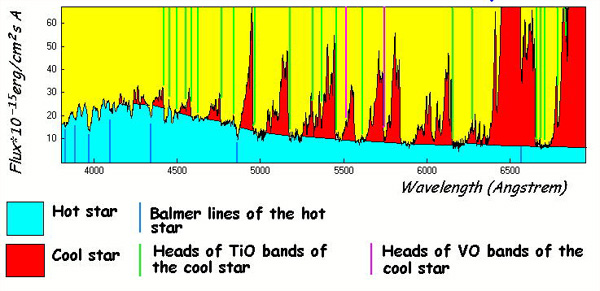
Two components of the system are seen in the spectrum of V838 Mon after outburst, a hot blue B3V type one having Balmer absorptions, and a cool 'brown' L type supergiant having deep absorption molecular bands of metal oxides. The absorption reaches 100 per cent in some strong bands, so as the B type star continuum is well seen. The interstellar reddening of E(B-V)=0m.77 is taken into account.
V838 Mon before the outburst was studied on the base of the plate collections of SAI, Moscow University and of Sonneberg Observatory, Germany, and digitized sky serveys. After its 2002 outburst, the star was studied on the base of UBVRI photometry. We found that the energy distribution before outburst coincided with a hot B3V star one. But after the outburst, the spectrum was two-component, and consisted of a hot B star, and a cool L type supergiant, the radiation of the last one was concentrated in the long-wavelength region. It is noted that the contribution of the hot star in the blue band decreased essentially relative to its pre-outburst level. There are two alternative explanations of this phenomenon. The first one suggests that the B type star participated in the outburst. The second one assumes that the object of the outburst was another B type star which mimiced its companion in the pre-outburst spectrum. And it is absent now in the integral energy distribution. Due to the contribution of one more B type star the integral brightness was higher. In any case V838 Mon is a binary system.
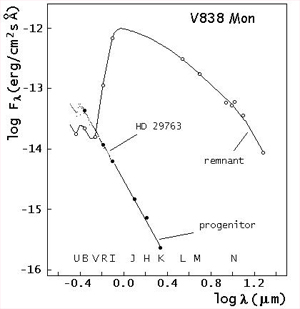
Spectral energy distributions of V838 Mon before outburst (progenitor) and after outburst (remnant). IR waverange data before outburst are from 2MASS, and those ones after outburst are from Linch et al., IAUC No.8221, 2003 and Tapia & Persy, IAUC No.8241, 2003. The energy distribution of progenitor is compared with B3V type star HD 29763 (the difference of interstellar reddening between star spectra are taken into account).
Light echo of V838 Mon
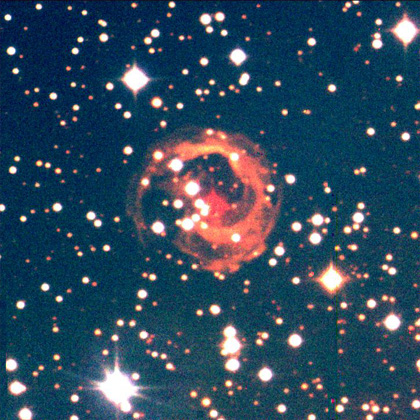
Colour image of the light echo around V838 Mon taken with the 1-m telescope of SAO RAS on December 30, 2003. Note that the star, V838 Mon is located not in the center of the round nebula illuminated by the outburst light.

Propagation of the light echo boundary in four directions versus time. Note that the velocity of the propagation decreases during the first months of observations, and the echo edge moves away with different velocities depending on direction.
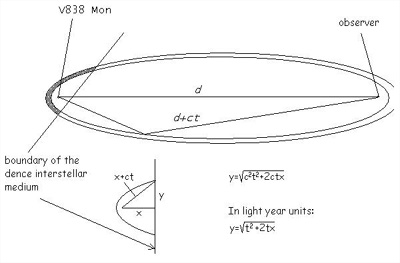
Modelling of light echo.. The light of the outburst peak illuminates in the given time t for an external observer the particles of the interstellar medium located along the 3D surface of expanding ellipsoid, so as the source of the outburst, and the observer turn up in its focal points, and the sum of the distances between each particle and focal points is equal to d+ct (where d is a distance from the observer to the star). The non-central location of the outburst source relative to the edge of the nebula may be explained with the assumption that the boundary of the dence interstellar medium is inclined to the line of sight (upper Figure). The light propagates along the line of the intersection between the face-on plane and the plane boundary of the interstellar medium according to the simplified formula y(x,t) for the remote observer, where x is the depth of immersion the outburst source into interstellar medium (see formula at the bottom of the Figure). Analysis of this formula shows that the apparent velocity of the edge propagation is always superluminal, and approaches to the value of light velocity asymptotically from upper side. So, we are in a position to determine distance to V838 Mon with the accuracy improving with the time of observations. Using the plot in the previous Figure, the distance may revealed of about 4 Kps. (In the general case, the equations for the light echo propagation are derived by R.Tylenda, AsAp V.414, 223, 2004).
Photometry of V4332 Sgr
The outburst of V4332 Sgr has happened in 1994, and observed only at its late stages because the object was located in the direction of the Sun. The detailed spectroscopic and photometric study of the star in outburst was published by Martini et al. (ApJ V.118, 1034, 1999). During the light decay the spectrum varied from K3-4III-I to M3III-I. In the quiet state after outburst, the emission lines H, MgI, FeI, FeII, [OI] were seen in the spectrum. This property distinguishes the star from V838 Mon which doesn't show the emissions in the quiet state. The cool star is presented in the red and IR spectrum by the molecular bands TiO and VO. The spectra of V4332 Sgr taken in 2003 by Banergee and Ashok (ApJ V.604, L57, 2004) look unusually with bright emissions NaI, K I, and RbI, and molecular bands of TiO in emission.
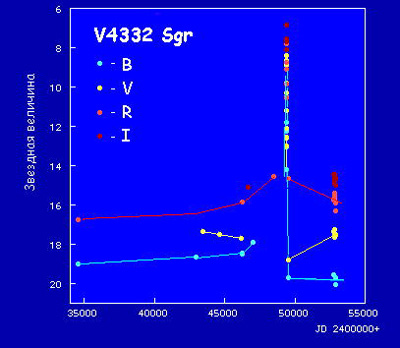
Historical light curves of V4332 Sgr in BVRI bands. See modern data here.
The duplicity of V4332 Sgr is not yet discovered. We have studied this star using digitized sky serveys. We found also six plates with the pre-outburst images of V4332 Sgr taken in 1977-1986 with the 50-cm meniscus telescope AZT-5 in the B and V bands. Comparing the measures of historic negatives, and modern CCD observations, we found that the brightness of V4332 Sgr fell down by 0m.6 relative its pre-outburst level, like this one of V838 Mon.
So, three known peculiar novae show the essential similarities in the photometric and spectroscopic behaviour to declare the discovery of a new class of astrophysical objects and variable stars. At the same time two galactic novae of this class display the spectral difference in its quiet states.
